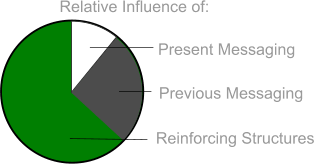Picture: a swimmer as they reach the end of the pool. They flip, push off the wall, and in a moment they are moving powerfully in a new direction.
Your organization’s strategic planning review should be like a swimmer’s turn – crisp, powerful – situation understood, activities redefined, accountabilities altered, and people informed – moving forward.
It’s the ‘push’, however, the resulting actions – execution, which determines a plan’s effectiveness. It is one of the most important ways by which employees and stakeholders evaluate management.
The key to a strong, crisp push? Add to your review’s implementation some powerful organizational change techniques.
Benefits:
- Improved performance,
- Stronger unity (coherence),
- Increased engagement, and as a side-benefit,
- Increased respect for management.
Increase Your Strategic ‘Push’
- A crisp, comprehensive, and action-able strategic review
- Convert your new strategy into operational activities
- Package your message to bring people and their energy with you
- Use Reinforcing Structures to communicate and motivate every person, every day
But before we cover these four points, let’s address the main reason why an organizational-change implementation is critical as you seek to convert your strategic plan into daily action.
Here it is:
Your organization constantly communicates what is important to your people, even when management isn’t saying anything.
How?
Three ways: Present Messaging, Past Management, and Reinforcing Structures
To be effective your implementation needs to address and leverage these methods:
1. Present Messaging
What is now said. This is the current set of visual, verbal, and written messages commonly associated with ‘communication,’ including speeches, newsletters, PowerPoint slide decks, letters from Executive Directors, and audio and video summaries. While important, present messaging has less impact on employee decisions and behavior than leaders believe.
2. Past Management
What was said and acted upon in the past. People have surprisingly long memories about the decisions previous management teams have made especially concerning perceived inequities in the treatment of employees. Employees expect new management to act like those that have gone before.
This cynical (but often realistic) expectation by employees causes them to discount today’s management messages (talk) while staff wait for management’s actions (walk) to resemble the patterns set by previous management.
Changing people’s view of past management is very difficult, but it explains in part, the lack of enthusiasm when employees hear about new directions. Current management should continue to demonstrate their professionalism and care for employees until the weighted average of employee perception begins to include current management’s track record.
3. Reinforcing Structures™
The actions management reinforced in the past. Reinforcing Structures are motivational mechanisms: policies, procedures, incentives, and configurations, which powerfully exert influence on employee behaviors and decisions due to personal impact on their compensation, esteem, and careers.
Although these Reinforcing Structures are in place now, they were developed and implemented in the past. This layering of reinforcing devices over time creates a patchwork, as each new policy, procedure, performance metric, incentive, or accountability corresponds to the thinking and business situation of the date of its installation.
Implication
Organizations cannot help but send a mixed or at least a hybrid message to staff. While employees listen to current management, they are invariably influenced by previous leaders. This is even more evident and confusing for employees in an organization that has merged with another.
Which communication component has the greatest influence?
- Present Messaging – small
- Past Messaging – larger
- Reinforcing Structures – largest of all
For Your Organization
Unless your strategic review and implementation accommodates and incorporates these elements, the ‘push’ off into your new direction will be significantly less than expected.
Building Your Review
In the following four brief notes, we will cover some of the essentials you and your board should consider as you push into a new direction.
Keith Miles MBA is a management consultant who helps organizations improve performance and engagement. Content adapted from his book, “The Improvement Toolbox” – website: smgknowledge.com Comments-questions: kmiles@smgknowledge.com
© Streamlined Management Group Inc. 2013– all rights reserved
